Streches
Posted on December 18th, 2011 by Andries Lodder
Tips For Stretching
The aims of stretching are to gently lengthen muscles before and after any form of exercise, and to improve tissue elasticity / flexibility. If done correctly, stretching will help prevent injuries and increase athletic performance.
The following key points should be remembered whilst stretching:
- Begin with gradual mobility exercises of all the joints, i.e. simply rotate the wrists, bend the arm and roll your shoulders. This will allow the body’s natural lubrication (synovial fluid) to protect the surface of your bones at these joints.
- Always warm up the body prior to stretching, as this increases blood flow around the body, which in turn makes the muscles more supple.
- After exercise, slowly bring your heart rate down before you begin stretching in order to avoid blood pooling within your muscles, which can lead to cramp and dizzy spells.
- If you’re wet and sweaty, take a bath or shower then stretch, as the hot water will help relax the muscles, and prevent you from catching a chill.
- Never bounce whilst you stretch, unless you are doing specific stretches for certain sports, i.e. ballistic stretching for martial arts.
- Hold the stretch until you feel the muscle loosen off, then repeat for a further 15 seconds.
- Whilst stretching you should feel some slight discomfort, if you don’t feel anything, then you may be doing the stretch incorrectly, or simply the muscle has eased off.
- Stop immediately if you feel any severe pain.
- Remember to breathe regularly and rhythmically, do not hold your breath.
- Start with your legs, and work up the body, in order not to miss out any stretch.
Adductor Stretch
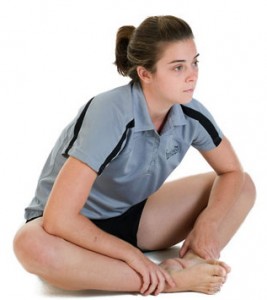
Sitting on the floor with the soles of the feet together, place your hands either around your ankles or lower legs. Keeping your back straight gently open out the knees towards the floor, applying a steady stretch onto your adductor / inner thigh muscles. The elbows can be pressed against the inner knee to increase the stretch. Avoid pulling up on your feet during the stretch.
- Make sure you warm-up prior to stretching.
- Hold for a period of 20 / 30 seconds.
- Stop immediately if you feel any pain.
Calf Stretch
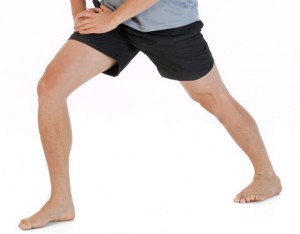
Standing one foot in front of the other, feet comfortably apart, both feet facing forward, front leg bent (knee over ankle joint), back leg straight, back straight.Press the heel of the back leg into the floor until a stretch is felt in the calf muscle in the back of the lower leg. If no stretch is felt, slide the heel slowly backwards, keeping the foot on the floor.For improved stability and a greater stretch, push against a wall.
Glutes (Buttocks) Stretch
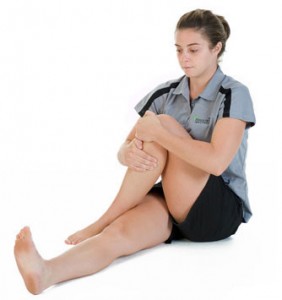
Sit up with your left leg out straight, and your right leg crossed over at about the knee joint, placing the foot flat on the floor. Using your right arm, pull the bent left leg slowly across, until you feel the stretch in the right buttock region. Simply reverse both leg and arm to do the other side.
Hamstring Stretch
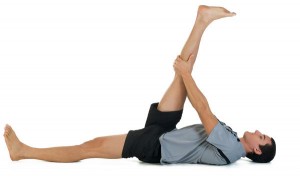
Lie on your back, bending one leg keeping that foot on the floor, to prevent you lifting your buttocks during the stretch. Raise your other leg, holding it either side of your knee joint, to gradually pull the leg towards you. You should feel the hamstring muscle stretching at the back of this leg. Concentrate on keeping your buttocks on the floor, and keeping the stretched leg as straight as possible.
Lower Back
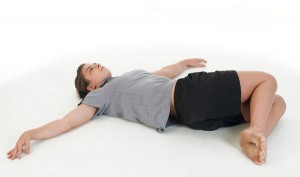
Lie on your back, with your legs bent up towards you. Keeping your upper back firmly on the floor, gently lower your knees to one side, hold for about 20 seconds, then repeat on the other side. Allow your lower back to rotate naturally to the side, however if any pain is felt avoid this stretch.
Upper Back
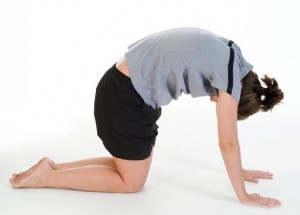
Whilst on all fours, look down towards the floor, then push your shoulders as high as they can go. This stretch is often called a cat stretch, due to the motion made. Aim to hold in the stretched up position for 10 seconds before repeating.
HIP FLEXORS
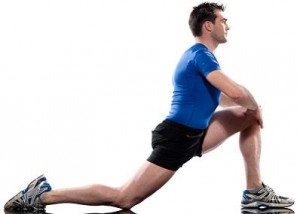
Place one leg forward with your knee above your toe, and the other stretched back with that knee touching the floor. Your hands can be placed on the front leg or floor to aid balance. Slowly push the pelvis forward until you feel the stretch in the upper thigh / hip flexor muscle of the rear leg.
Tweet